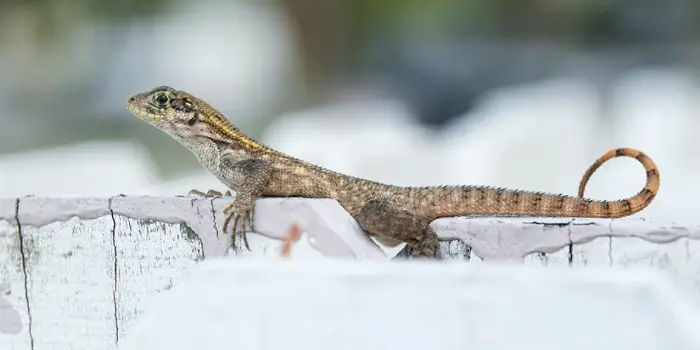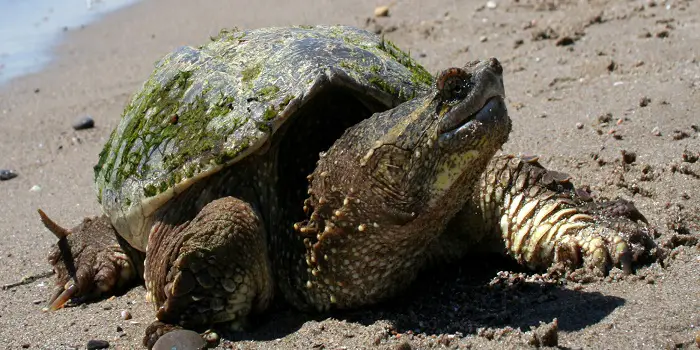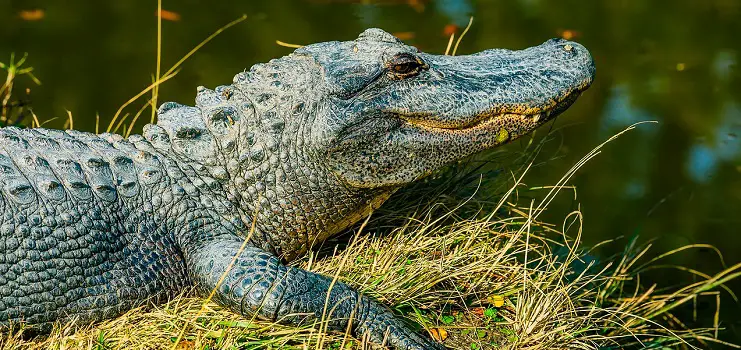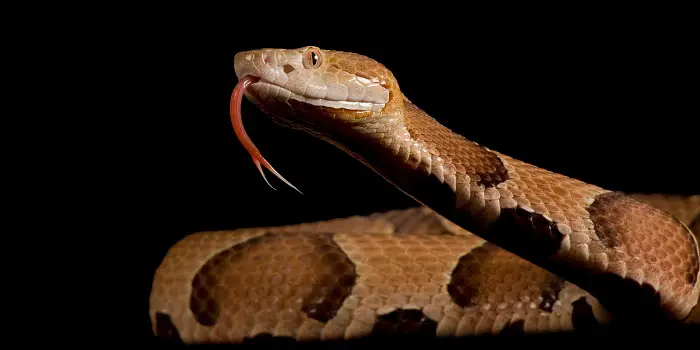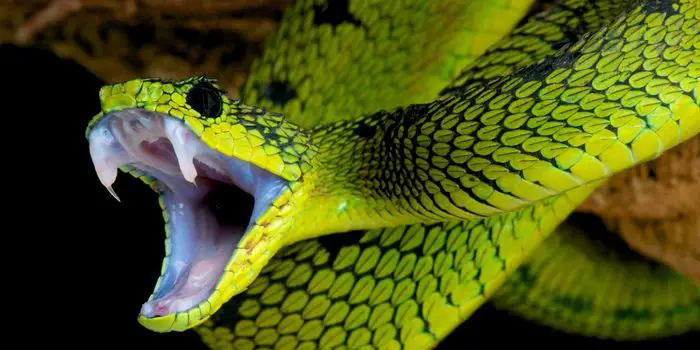
The Gaboon viper, which is one of the world’s largest and heaviest vipers, has the longest fangs of any venomous snake.
The fangs of Gaboon viper often measure two inches long or more and can be folded up against the roof of the snake’s mouth when it’s not in use.
With such long fangs, the Gaboon viper is able to deliver a large amount of venom in a single bite.
The venom of the Gaboon viper is primarily composed of neurotoxins, which can cause paralysis and death if not treated immediately.
Further in this article, I will discuss a few other snakes that have the biggest fangs in the world. But before that, let’s look at some interesting facts…
What is Snake Fangs?
Snake fangs are thin, sharp teeth that are connected to a small reservoir-like sac located behind a snake’s eyes. Venom is stored in these reservoirs.
Snake fangs may be a groove or hollow, and they help the venom from the sac pass through the teeth and into the prey’s poked skin or eyes – as with spitting cobras.
There are over 3,000 different snake species on the planet. However, don’t be frightened by this figure because only 200 of the species are poisonous, and only about 100 can actually kill or severely damage a human.
Only venomous snakes have fangs, while most snake species have teeth that perform various tasks.
Snakes use their fangs as needles to inject venom into their prey, killing it with toxins that cause terrible agony and cell death in various ways.
When a snake bites or spits, the venom is delivered to its prey and begins to work immediately. Snakes’ different degrees of venom make some snake bites survivable while others are fatal.
Different Types of Snake Fangs
Vipers, Elapids, and Colubrids are three types of venomous snakes, each with its own fang.
a) Solenoglyphous
Solenoglyphous fangs, found on vipers, are hollow and foldable to allow them to inject venom as deep into their prey as possible. They are also the longest and most dangerous fangs that can be found in snakes.
Comparable to hypodermic needles, they transmit venom quickly and efficiently from the snake into its victim through openings in their teeth.
Their long forms also enable them to lock their prey in their jaws for a prolonged period of time.
b) Proteroglyphous
Elapid snakes have what are called proteroglyphous fangs, which cannot be extended or moved like solenoglyphous fangs found in other snake species.
Even though they’re shorter, some of these venom-emitting snakes can actually inject their poison at higher speeds than those with the aforementioned type of fang.
Additionally, certain members of this family usually carry more than one fang in each tooth pocket – helping them to firmly grip struggling prey and pump greater amounts of deadly fluid into their system.
c) Opisthoglyphous
Mostly, the colubrids group contains snakes of the Xenodontinae subfamily. They are too many to list here, but some popular ones are worm snakes, mud snakes, and ringneck snakes.
These reptiles have their fangs located toward the back of their mouths rather than the front.
Consequently, these animals must chew on their prey to get their poison in them. Although this usually makes most of their bites non-lethal.

Snakes with Biggest Fangs in the World
Generally, the size of a snake’s fang is in relation to how large the snake is. However, some snakes have considerably larger fangs than others.
Since vipers have Solenoglyphous fangs, snakes in this group typically have the biggest fangs. Listed below are five vipers with what are widely considered to be the world’s biggest fangs.
1- The Gaboon Viper
The Gaboon viper is the king of snakes (based on fang length) found in rainforests and savannas throughout sub-Saharan Africa.
It typically takes first place on our list, with the longest fangs and venom production of any snake species.
The Gaboon viper’s teeth have been reported to develop up to 2 inches in length.
Interestingly, the gaboon viper is also the snake with the largest head in the world – measuring up to 6 inches across.
They can grow between 48-84 inches in length and are known to weigh more than 45 pounds.
2- Puff Adder
As adults, puff adders measure about 3 feet and have fangs as large as 0.79 inches. They are also known to cause more snake bites than any other species in Africa.
The venom yield of this species is usually 150-350 mg, with a maximum of 700-750 mg.
Mostly, They eat rodents, birds, lizards, small mammals, and toads by waiting patiently to ambush them, sometimes even lying in waiting for weeks.
3- Golden Lancehead
Golden Lanceheads can grow up to 28 inches long. They are commonly found in Brazil and have golden-colored scales with triangular heads.
Their fangs measure an average of 0.79 inches, meaning they can insert their venom deeply after breaking their prey’s skin–which makes them highly dangerous.
So, if you see one, be sure to report it to the authorities immediately.
4- The Eastern Diamondback Rattlesnake
Eastern diamondback rattlesnakes are famous for their enormous fangs, which can reach an inch in length.
They make this list because they have a particularly large pair of fangs.
Because adult eastern diamondback rattlesnakes typically measure around 4 feet long, one would expect that their fangs would be only about 0.75 inches long.
But this snake species has a superior fang-to-body proportion.
Eastern diamondback rattlesnakes also have high venom yields depositing an average of 400–450 mg and a maximum of 858–1,000 mg of venom per bite.
5- The Western Diamondback Rattlesnake
Western diamondback rattlesnakes are normally about four feet in length. They have fangs that can extend up to 0.75 inches, but some snakes of this species have been found with fangs measuring a whopping 1.25 inches.
When they feel threatened, these snakes will rattle their tail and coil up before striking their attacker.
An average bite from a western diamondback injects between 250 and 350 mg of venom into its victim, although doses as high as 800 mg have been recorded.
Are There Any Fangless Snakes Around the World?
Snakes’ fangs and jaws are what give them their frightening, slithery appearance.
But snakes that don’t have teeth are real. There are snakes without fangs, and they’re not dangerous in any way.
Dasypeltis, Indian Egg-Eating Snakes, Milk Snakes, and Green Snakes are just a few of the toothless snakes out there to name.
An interesting fact, if you don’t know, is…
Despite having fangs, snakes may often choose not to inject venom when they bite – it’s called a dry bite.
A “dry bite” occurs when a snake does not want to release poison. This usually happens during self-defense, when snakes use dry bites because they are unwilling to consume the prey but only desire to flee.
Can Snakes Bite Through Leather Boots Made of Leather or Rubber?
Although most snakes can’t usually bite through thick leather cowboy boots, their thin fangs can pierce thinner rubber material and leather footwear delivering the venom.
Also, some larger venomous snakes, like the eastern diamondback rattlesnake, have fangs that are long and sharp enough to pierce thick leather boots.
So, if you’re ever in snake country, be sure to wear thick-soled boots made of sturdy material!
Also, when you work around horse barns or ride in the woods, you’re likely to come across snakes.
Hence, it’s also essential to wear boots that are built to protect your lower legs and feet from snake bites if you hunt or work in an area where there are snakes with the largest fangs found.
Despite taking all the precautions, if you happen to encounter one of the deadliest snakes, try to move slowly and calmly.
Do not ever try to pick up a snake, and note that a snake’s striking distance is typically half its length.
So, if you see a four-foot rattlesnake, it can still bite you from two feet away.
If you get bitten by a snake, try to remain calm and call for medical help immediately. Do not try to suck out the venom or make any cuts on the wound.
The best thing you can do is to keep the affected limb immobilized and close to the level of your heart until you receive professional medical help.
One final tip, if you happen to come across a snake, give it a wide berth, and it will usually slither away.
Share the post "Snake with Longest Fangs – Do You Know Them?"

Welcome to ProShieldPest.com. I am Tina Jones. I have been working as a pest removal professional in Winslow, Arizona lately. At present, I love to spend my time with my family as a retiree.
Here I share all my knowledge and experiences to help people understand better how they can stop pests at their homes without actually killing them. Hopefully, the information you will find here will help in safeguarding your home! You can check more about me here.

